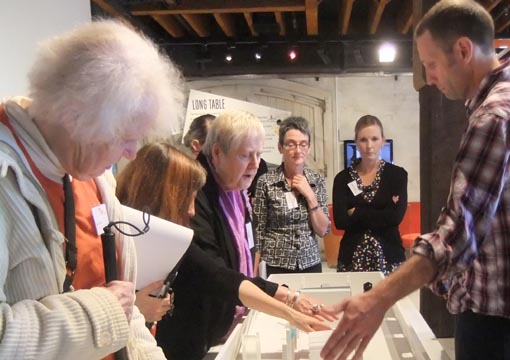In 2014 we were at the beginning of our accessibility journey. At the same time, our thinking around Wellington Museum’s proposed exhibition - The Attic - was taking shape.
We were naively assuming that accessibility was something we would achieve and we hadn’t quite realised it was something we would always be working towards.
I have to say our approach, although well-intentioned, largely involved doing it for the disabled community.
 Thankfully, and with perfect timing, it was at this stage our relationship with Arts Access Aotearoa and the Arts For All Network began.
Thankfully, and with perfect timing, it was at this stage our relationship with Arts Access Aotearoa and the Arts For All Network began.
We were given a first edition copy of Arts For All and seized on particular pages of the book: Getting Started, First Steps, Ten Things You Can Do Now, What Words to Use, and Where to Go For Advice and Information. Our thinking began to change.
We attended an Arts For All Wellington Network hui and met members of the disability sector. Our thinking changed a little further.
We were chatting with Richard Benge, the Executive Director of Arts Access Aotearoa, about an accessibility policy for our museums when The Attic came into the conversation. He suggested the museum host a Network hui, share our plans and ask for input. Our practice began to change.
 At the Network hui designer David Waller had a tactile scale model of the floor and the display cabinets/furniture. He talked the Network members through his designs and they fed back to him.
At the Network hui designer David Waller had a tactile scale model of the floor and the display cabinets/furniture. He talked the Network members through his designs and they fed back to him.
The hui was constructive and collaborative. Network members with lived, familial or community experience of disability and access requirements talked through all aspects of the design, answered David’s questions, and gave information on guidelines and minimum requirements.
They introduced us to Standard 4121, suggested contacts and readings, and told us about their experiences and how we could incorporate or learn from them. They were positive about the thinking to date, and encouraging about what we could aspire to, what would be the very best we could do at this time for this exhibition.
Keeping in touch
Several members generously handed over their contact details inviting us to keep in touch or ask for assistance.
David acknowledges The Attic is what it is due to the conversations he had with the group.
 He credits these as making him both aware and mindful of accessible design aspects and has indicated that without the network’s input The Attic would have been vastly different.
He credits these as making him both aware and mindful of accessible design aspects and has indicated that without the network’s input The Attic would have been vastly different.
He notes that the feedback the network gave him has resulted in a more accessible/inclusive experience for all. These days Standard 4121 is such a part of his thinking I believe he has it memorised.
Curator Brent Fafeita speaks from a content point of view. For him, his thinking around interpretation and story selection were enhanced at the hui. It was here he realised the importance of engaging with the disability sector – planning with a person not for them.
This led him to collaborate with World Champion swimmer and Paralympian Mary Fisher on an exhibition in The Attic, and not only that, but after the opening for them to work together again to make adjustments that would improve the experience for visitors who are blind or with low vision.
Value of belonging to Arts For All Network
I hope Wellington Museum’s experience illustrates just how valuable it is to belong to one of the five regional Arts For All Networks. To hammer it home I’d say the network gave, and continues to give, us:
- the opportunity to form and maintain relationships
- the opportunity to listen
- support and learning
- connections and networks
- the opportunity to participate in training
- next steps in our accessibility journey.
I’d add, and I think this is key, that before the hui we had accessibility champions in the museum. Now we have relationships with disabled people and disability organisations, and a culture of accessibility and inclusion.
Rachel Ingram, Head of Learning and Programmes, Wellington Museum, gave this abridged presentation on the Arts Access Aotearoa panel on diversity and disability at MA17, Museums Aotearoa’s national conference in May.


